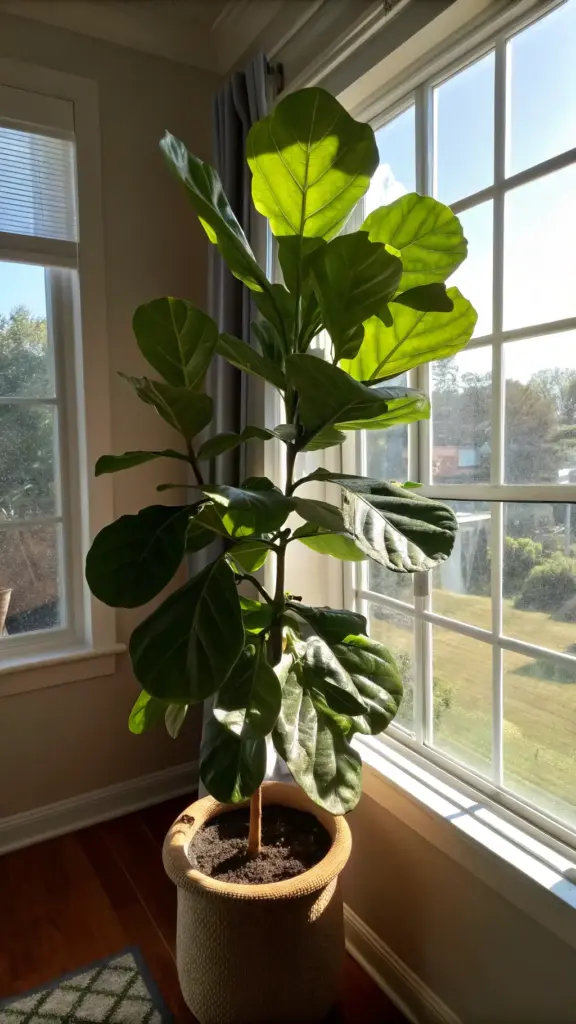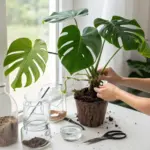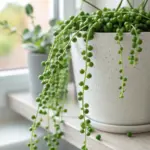2. Poor Lighting is Stunting Your Plant’s Growth

I spent months wondering why my fiddle leaf fig looked like it was slowly giving up on life. The leaves were small, the growth was pathetic, and honestly, I was getting pretty frustrated with this supposedly “easy” houseplant.
Then I moved it from my dim living room corner to a bright east-facing window. Within three weeks, I had new growth that was literally twice the size of the sad little leaves it had been producing.
That’s when it hit me – lighting requirements aren’t just suggestions for fiddle leaf figs, they’re absolutely critical for survival.
Understanding What Your Fiddle Leaf Fig Actually Needs
These plants are basically bright indirect light addicts. In their natural habitat, they’re getting filtered sunlight through a forest canopy – think bright but not harsh.
They need about 6-8 hours of quality light per day to really thrive. Anything less and you’ll get that slow, stunted growth that makes you question your plant parenting skills.
The key word here is “indirect” though. Direct sunlight will literally scorch those beautiful big leaves faster than you can say “plant emergency.”
Red Flags: When Your Lighting is All Wrong
Insufficient light symptoms are pretty obvious once you know what to look for. Your fiddle leaf fig will start stretching toward the nearest light source, creating this weird, leggy appearance.
The leaves will be smaller than normal and spaced far apart on the stem. It’s like your plant is desperately reaching for more light and forgetting to fill out properly.
You might also notice the lower leaves turning yellow and dropping off. This is your plant basically saying “I can’t support all these leaves with this pathetic amount of light.”
Too much direct light creates a totally different problem. You’ll see brown, crispy patches on the leaves – usually starting on the side that faces the window.
The leaves might also fade from that gorgeous deep green to a washed-out, pale color. Think of it like your plant getting a really bad sunburn.
Window Placement Strategies for City Living
East-facing windows are absolute gold for fiddle leaf figs. They get that gentle morning sun without the harsh afternoon heat that can damage leaves.
I live in a typical city apartment, and my east window gives perfect filtered morning light for about 4-5 hours. Then it’s bright indirect light for the rest of the day.
South-facing windows can work, but you need to be smart about it. Place your fiddle leaf fig about 3-4 feet back from the window, or use a sheer curtain to diffuse that intense midday sun.
North-facing windows are usually too dim unless you’re supplementing with artificial light. West-facing windows can be tricky because of that harsh afternoon sun – proceed with caution.
Grow Lights: Your Indoor Gardening Game Changer
I was skeptical about LED grow lights at first, but they’ve been a total lifesaver for my darker spaces. Look for full-spectrum lights that provide at least 2000-3000 lumens.
The key is positioning them about 12-18 inches above your plant and running them for 12-14 hours per day. I use a timer so I don’t have to remember to turn them on and off.
Fluorescent grow lights work too, but they need to be much closer to your plant – about 6-12 inches away. They also generate more heat, so watch for signs of stress.
Don’t cheap out on grow lights if you’re serious about plant health. A good LED setup will pay for itself in happy, thriving plants.
The Art of Light Acclimation
Moving your fiddle leaf fig to a brighter spot isn’t like flipping a switch. Gradual light adjustment is crucial to prevent shock and leaf burn.
I learned this lesson when I moved my plant from a dim corner directly to a sunny window. Half the leaves dropped within a week – it was like plant trauma in real time.
Start by moving your plant to the new location for just 2-3 hours per day. Gradually increase the exposure over 2-3 weeks until it’s there full-time.
Watch for signs of stress during this acclimation period – if you see leaf drop or browning, slow down the process.
Creative Solutions for Challenging Spaces
Light-colored walls can be your secret weapon for maximizing available light. I painted the wall behind my plant a soft white, and it made a noticeable difference in overall brightness.
Mirrors strategically placed near your plant can help reflect and amplify natural light. Just don’t create focused beams that might burn your leaves.
If you’re dealing with a truly dark space, consider light-reflecting plant stands or white pebble trays that bounce light upward toward the leaves.
Sometimes you just have to accept that certain spots in your home aren’t meant for fiddle leaf figs. It’s better to find a plant that actually thrives in low light than to torture a light-loving species.
Think you’ve got the lighting figured out? Click “next” to discover the humidity mistake that’s probably sabotaging your fiddle leaf fig right now – plus the $5 trick that can instantly improve your plant’s health!









GIPHY App Key not set. Please check settings